-
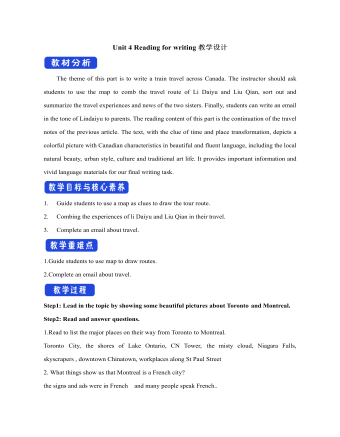
新人教版高中英语选修2Unit 4 Reading for writing教学设计
假定你是英国的Jack,打算来中国旅行,请你给你的中国笔友李华写一封信,要点如下:1.你的旅行计划:北京→泰山→杭州;2.征求建议并询问他是否愿意充当你的导游。注意:1.词数80左右(开头和结尾已给出,不计入总词数);2.可以适当增加细节,以使行文连贯。参考词汇:故宫 the Forbidden City;泰山 Mount TaiDear Li Hua,I'm glad to tell you that 'm going to visit China.First,I am planning to visit Beijing,the capitalof China,where I am looking forward to enjoying the Great Wall,the Forbidden City and somebeautiful parks.Then I intend to go to visit Mount Tai in Shandong Province.I've heard that it is one ofthe most famous mountains in China and I can't wait to enjoy the amazing sunrise there.After that,I amalso going to Hangzhou.It is said that it is a beautiful modern city with breathtaking natural sights,among which the West Lake is a well- known tourist attraction.What do you think of my travel plan? Will you act as my guide? Hope to hear from you soon.

新人教版高中英语选修2Unit 4 Using langauge-Listening教学设计
The theme of the listening section is " talking about scenery and culture along a journey."The part is designed to further lead the students to understand Canadian natural geography and social environment, and integrated into the cultural contrast by mentioning the long train journey from Beijing to Moscow routes. On this basis, the part activates students related travel experience, lets the student serial dialogue, guides the student to explore further the pleasure and meaning of the long journey, and Chinese and foreign cultural comparison.The part also provides a framework for the continuation of the dialogue, which is designed to provide a framework for students to successfully complete their oral expressions, and to incorporate an important trading strategy to end the dialogue naturally.1. Help students to understand and master some common English idioms in the context, and experience the expression effect of English idioms.2. Guide the students to understand the identity of different people in the listening context, and finish the dialogue according to their own experience.3. Instruct the students to use appropriate language to express surprise and curiosity about space and place in the dialogue, and master the oral strategy of ending the dialogue naturally.1. Instruct students to grasp the key information and important details of the dialogue.2. Instruct students to conduct a similar talk on the relevant topic.

新人教版高中英语选修2Unit 5 Learning about Language教学设计
The purpose of this section of vocabulary exercises is to consolidate the key words in the first part of the reading text, let the students write the words according to the English definition, and focus on the detection of the meaning and spelling of the new words. The teaching design includes use English definition to explain words, which is conducive to improving students' interest in vocabulary learning, cultivating their sense of English language and thinking in English, and making students willing to use this method to better grasp the meaning of words, expand their vocabulary, and improve their ability of vocabulary application. Besides, the design offers more context including sentences and short passage for students to practice words flexibly.1. Guide students to understand and consolidate the meaning and usage of the vocabulary in the context, 2. Guide the students to use the unit topic vocabulary in a richer context3. Let the students sort out and accumulate the accumulated vocabulary, establishes the semantic connection between the vocabulary,4. Enable students to understand and master the vocabulary more effectivelyGuiding the Ss to use unit topic words and the sentence patterns in a richer context.Step1: Read the passage about chemical burns and fill in the blanks with the correct forms of the words in the box.
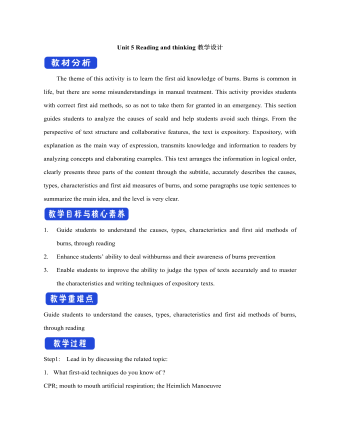
新人教版高中英语选修2Unit 5 Reading and thinking教学设计
The theme of this activity is to learn the first aid knowledge of burns. Burns is common in life, but there are some misunderstandings in manual treatment. This activity provides students with correct first aid methods, so as not to take them for granted in an emergency. This section guides students to analyze the causes of scald and help students avoid such things. From the perspective of text structure and collaborative features, the text is expository. Expository, with explanation as the main way of expression, transmits knowledge and information to readers by analyzing concepts and elaborating examples. This text arranges the information in logical order, clearly presents three parts of the content through the subtitle, accurately describes the causes, types, characteristics and first aid measures of burns, and some paragraphs use topic sentences to summarize the main idea, and the level is very clear.1. Guide students to understand the causes, types, characteristics and first aid methods of burns, through reading2. Enhance students’ ability to deal withburnss and their awareness of burns prevention3. Enable students to improve the ability to judge the types of texts accurately and to master the characteristics and writing techniques of expository texts.Guide students to understand the causes, types, characteristics and first aid methods of burns, through readingStep1: Lead in by discussing the related topic:1. What first-aid techniques do you know of ?CPR; mouth to mouth artificial respiration; the Heimlich Manoeuvre

新人教版高中英语选修2Unit 5 Using langauge-Listening教学设计
The theme of this section is to learn how to make emergency calls. Students should learn how to make emergency calls not only in China, but also in foreign countries in English, so that they can be prepared for future situations outside the home.The emergency telephone number is a vital hotline, which should be the most clear, rapid and effective communication with the acute operator.This section helps students to understand the emergency calls in some countries and the precautions for making emergency calls. Through the study of this section, students can accumulate common expressions and sentence patterns in this context. 1.Help students accumulate emergency telephone numbers in different countries and learn more about first aid2.Guide the students to understand the contents and instructions of the telephone, grasp the characteristics of the emergency telephone and the requirements of the emergency telephone.3.Guide students to understand the first aid instructions of the operators.4.Enable Ss to make simulated emergency calls with their partners in the language they have learned1. Instruct students to grasp the key information and important details of the dialogue.2. Instruct students to conduct a similar talk on the relevant topic.Step1:Look and discuss:Match the pictures below to the medical emergencies, and then discuss the questions in groups.
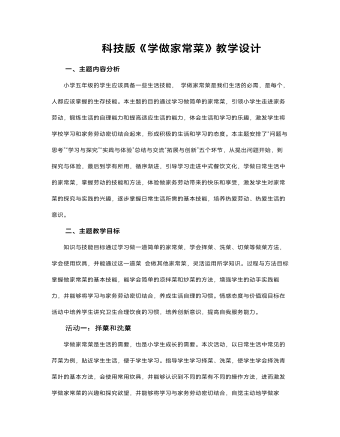
学做家常菜教学设计教案
小学五年级的学生应该具备一些生活技能, 学做家常菜是我们生活的必需,是每个,人都应该掌握的生存技能。本主题的目的通过学习做简单的家常菜,引领小学生走进家务劳动,锻炼生活的自理能力和提高适应生活的能力,体会生活和学习的乐趣,激发学生将学校学习和家务劳动密切结合起来,形成积极的生活和学习的态度。本主题安排了“问题与思考”“学习与探究”“实践与体验”总结与交流“拓展与创新”五个环节,从提出问题开始,到探究与体验,最后到学有所用,循序渐进,引导学习走进中式餐饮文化,学做日常生活中的家常菜,掌握劳动的技能和方法,体验做家务劳动带来的快乐和享受,激发学生对家常菜的探究与实践的兴趣,逐步掌握日常生活所需的基本技能,培养热爱劳动、热爱生活的意识。
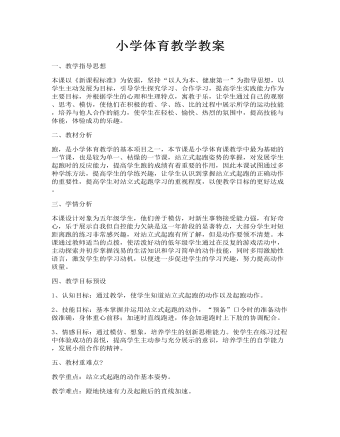
小学体育教学教案
二、教材分析跑,是小学体育教学的基本项目之一,本节课是小学体育课教学中最为基础的一节课,也是较为单一、枯燥的一节课,站立式起跑姿势的掌握,对发展学生起跑时的反应能力,提高学生跑的成绩有着重要的作用,因此本课试图通过多种学练方法,提高学生的学练兴趣,让学生认识到掌握站立式起跑的正确动作的重要性,提高学生对站立式起跑学习的重视程度,以便教学目标的更好达成。三、学情分析本课设计对象为五年级学生,他们善于模仿,对新生事物接受能力强,有好奇心,乐于展示自我但自控能力欠缺是这一年龄段的显著特点,大部分学生对短距离跑的练习非常感兴趣,对站立式起跑有所了解,但是动作要领不清楚。本课通过教师适当的点拨,使活泼好动的低年级学生通过在反复的游戏活动中,主动探索并初步掌握浅易的生活知识和学习简单的动作技能,同时多用激励性语言,激发学生的学习动机,以便进一步促进学生的学习兴趣,努力提高动作质量。
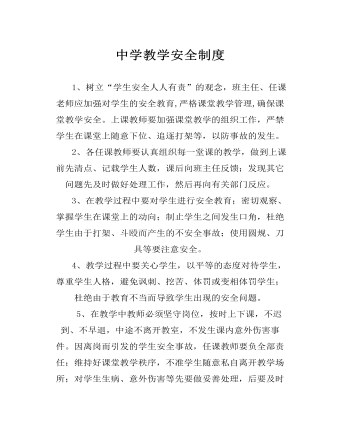
中学教学安全制度
2、各任课教师要认真组织每一堂课的教学,做到上课前先清点、记载学生人数,课后向班主任反馈;发现其它问题先及时做好处理工作,然后再向有关部门反应。 3、在教学过程中要对学生进行安全教育;密切观察、掌握学生在课堂上的动向;制止学生之间发生口角,杜绝学生由于打架、斗殴而产生的不安全事故;使用圆规、刀具等要注意安全。 4、教学过程中要关心学生,以平等的态度对待学生,尊重学生人格,避免讽刺、挖苦、体罚或变相体罚学生;杜绝由于教育不当而导致学生出现的安全问题。
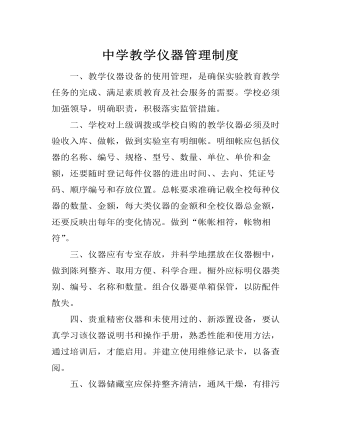
中学教学仪器管理制度
二、学校对上级调拨或学校自购的教学仪器必须及时验收入库、做帐,做到实验室有明细帐。明细帐应包括仪器的名称、编号、规格、型号、数量、单位、单价和金额,还要随时登记每件仪器的进出时间、、去向、凭证号码、顺序编号和存放位置。总帐要求准确记载全校每种仪器的数量、金额,每大类仪器的金额和全校仪器总金额,还要反映出每年的变化情况。做到“帐帐相符,帐物相符”。 三、仪器应有专室存放,并科学地摆放在仪器橱中,做到陈列整齐、取用方便、科学合理。橱外应标明仪器类别、编号、名称和数量。组合仪器要单箱保管,以防配件散失。
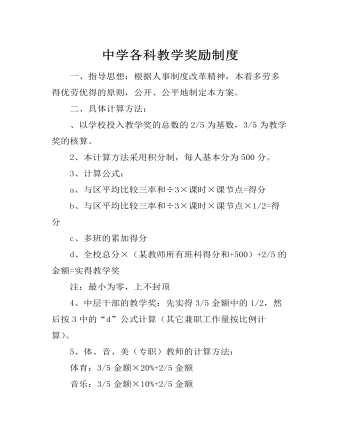
中学各科教学奖励制度
二、具体计算方法: 、以学校投入教学奖的总数的2/5为基数,3/5为教学奖的核算。 2、本计算方法采用积分制,每人基本分为500分。 3、计算公式: a、与区平均比较三率和÷3×课时×课节点=得分 b、与区平均比较三率和÷3×课时×课节点×1/2=得分 c、多班的累加得分 d、全校总分×(某教师所有班科得分和+500)+2/5的金额=实得教学奖 注:最小为零,上不封顶
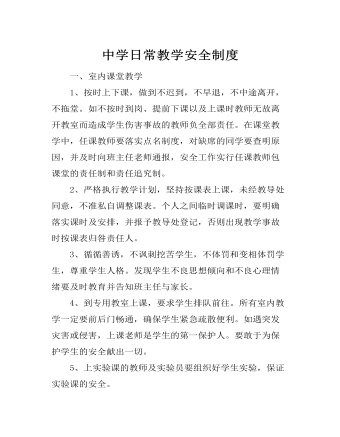
中学日常教学安全制度
2、严格执行教学计划,坚持按课表上课,未经教导处同意,不准私自调整课表。个人之间临时调课时,要明确落实课时及安排,并报予教导处登记,否则出现教学事故时按课表归咎责任人。 3、循循善诱,不讽刺挖苦学生,不体罚和变相体罚学生,尊重学生人格。发现学生不良思想倾向和不良心理情绪要及时教育并告知班主任与家长。 4、到专用教室上课,要求学生排队前往。所有室内教学一定要前后门畅通,确保学生紧急疏散便利。如遇突发灾害或侵害,上课老师是学生的第一保护人。要敢于为保护学生的安全献出一切。
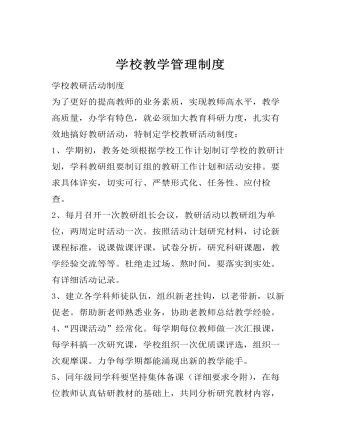
学校教学管理制度
1、学期初,教务处须根据学校工作计划制订学校的教研计划,学科教研组要制订组的教研工作计划和活动安排。要求具体详实,切实可行、严禁形式化、任务性、应付检查。 2、每月召开一次教研组长会议,教研活动以教研组为单位,两周定时活动一次。按照活动计划研究材料,讨论新课程标准,说课做课评课,试卷分析,研究科研课题,教学经验交流等等。杜绝走过场、熬时间,要落实到实处。有详细活动记录。

小学教学常规管理制度
一、教学常规与课程标准 、学期开始各年级各学科都要制定好学期教学计划,并努力做到教学目的明确,课时划分科学,教学进度清楚,时间分配合理,各人教研计划,于开学第一周上交办公室。 2、掌握本学科课程标准,做到学科教学目的清楚,教材结构清楚,学科特点清楚,重点难点清楚,学生的能力发展要求清楚。 二、备课 1、个人备课要做到备课程标准,备教材,备教学内容,备学生实际,备教学方法,备教学手段及教具,备教学练习,备能力培养措施,备德育美育的熏陶。 2、上课前必须写好教案,教案一般包括:课题、教学目标、重点难点、教学用具、教学过程、实验操作、作业布置、板书设计、课后小结。学期中应超前一周备课、教案字清楚整洁。 3、不得使用旧教案或以参考资料代替教案。
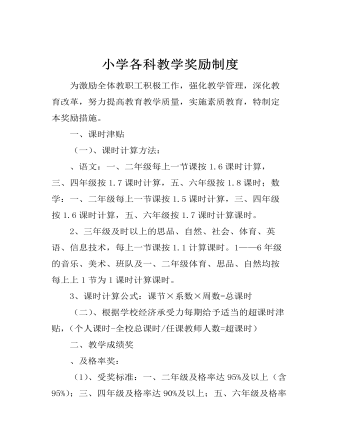
小学各科教学奖励制度
一、课时津贴 (一)、课时计算方法: 、语文:一、二年级每上一节课按1.6课时计算,三、四年级按1.7课时计算,五、六年级按1.8课时;数学:一、二年级每上一节课按1.5课时计算,三、四年级按1.6课时计算,五、六年级按1.7课时计算课时。 2、三年级及时以上的思品、自然、社会、体育、英语、信息技术,每上一节课按1.1计算课时。1——6年级的音乐、美术、班队及一、二年级体育、思品、自然均按每上上1节为1课时计算课时。 3、课时计算公式:课节×系数×周数=总课时 (二)、根据学校经济承受力每期给予适当的超课时津贴,(个人课时-全校总课时/任课教师人数=超课时) 二、教学成绩奖 、及格率奖: (1)、受奖标准:一、二年级及格率达95%及以上(含95%);三、四年级及格率达90%及以上;五、六年级及格率达85%及以上才能受奖。 (2)、奖励办法:凡达到标准要求者,根据所教班学生数,按每生1元计算,奖单科教师。 2、优生率奖: (1)、优生标准:一、二年级95分以上者;三、四年级90及以上者;五、六年级90分及以上者为优生。 (2)、奖励方法:按每科计算,优生每生奖1元。语文、数学双科优生,每生奖2元。 3、特优生奖:10元/生。 4、平均分奖:以区平均比较,每超一个百分点,按每生0.1元计奖。
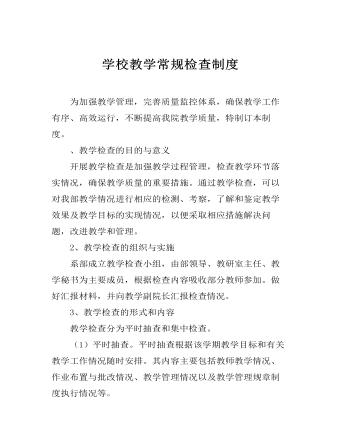
学校教学常规检查制度
开展教学检查是加强教学过程管理,检查教学环节落实情况,确保教学质量的重要措施。通过教学检查,可以对我部教学情况进行相应的检测、考察,了解和鉴定教学效果及教学目标的实现情况,以便采取相应措施解决问题,改进教学和管理。 2、教学检查的组织与实施 系部成立教学检查小组,由部领导、教研室主任、教学秘书为主要成员,根据检查内容吸收部分教师参加。做好汇报材料,并向教学副院长汇报检查情况。

学校教学安全管理制度
(2)严格执行教学计划,坚持按课表上课,未经教导处同意,不准私自调课。 (3)循循善诱,不讽刺挖苦学生,不体罚和变相体罚学生,尊重学生人格。 (4)在课堂教学中,任课教师要落实点名制度,对缺席的同学要查明去向,并及时向班主任老师通报,安全工作实行任课教师包课堂的责任制和责任追究制。 (5)上实验课的教师要组织好学生实验,保证实验课的安全。a上课教师要严格按教材要求做好实验准备,对所用药品,器材要在课前检查并进行预做,确保药品器材安全有效。不得让过期变质及存在安全隐患的器材、药品进入课堂。b上课教师要认真组织实验课的教学工作,必须做到:课前教师对要做的实验的整个过程能熟练操作;对存在一定安全问题的实验,教师上课时一定先讲实验要点和安全注意事项以及处理安全事故的必要知识;并对重要操作进行必要的示范和演示,实验的整个过程进行认真指导和全面监控,确保学生安全。c所有学生必须严格遵守实验室管理制度及操作规程,严格遵守操作规程及实验步骤,不懂就问,有问题及时向老师汇报。
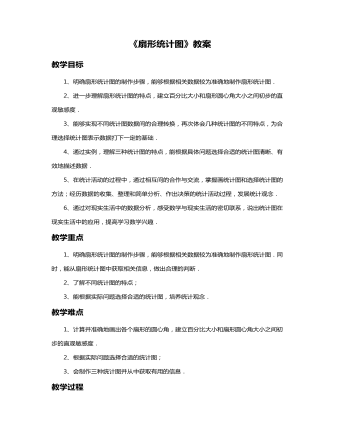
扇形统计图教案教学设计
教学目标1、明确扇形统计图的制作步骤,能够根据相关数据较为准确地制作扇形统计图.2、进一步理解扇形统计图的特点,建立百分比大小和扇形圆心角大小之间初步的直观敏感度.3、能够实现不同统计图数据间的合理转换,再次体会几种统计图的不同特点,为合理选择统计图表示数据打下一定的基础.4、通过实例,理解三种统计图的特点,能根据具体问题选择合适的统计图清晰、有效地描述数据.5、在统计活动的过程中,通过相互间的合作与交流,掌握画统计图和选择统计图的方法;经历数据的收集、整理和简单分析、作出决策的统计活动过程,发展统计观念.6、通过对现实生活中的数据分析,感受数学与现实生活的密切联系,说出统计图在现实生活中的应用,提高学习数学兴趣.

李商隐诗两首教学设计教案
我们不妨将主旨放在“庄生晓梦迷蝴蝶,望帝春心托杜鹃。沧海月明珠有泪,蓝田日暖玉生烟。”二联之前,那么,事情就变得简单起来了:华年如庄生晓梦迷蝴蝶;华年如望帝春心托杜鹃;华年如沧海月明珠有泪;华年如蓝田日暖玉生烟。从课下注释,我们很容易就可以看出,这四句每一句都在用典。因此,我们通过对典故的解读,然后加以整理,将其理顺,似乎就可以完成对诗歌内容的解读;至于什么悼亡、爱情,不妨抛之脑后,毕竟,没有那些其他的主题,也并没有让诗歌失色,而加上这些捉摸不定的主题,只是让诗歌增加了所谓的神秘色彩,徒增阅读难度而已。
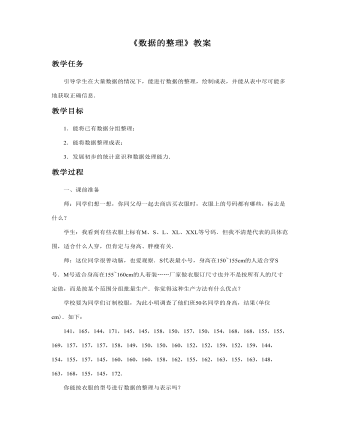
数据的整理教案教学设计
一、课前准备师:同学们想一想,你同父母一起去商店买衣服时,衣服上的号码都有哪些,标志是什么?学生:我看到有些衣服上标有M、S、L、XL、XXL等号码.但我不清楚代表的具体范围,适合什么人穿,但肯定与身高、胖瘦有关.师:这位同学很善动脑,也爱观察.S代表最小号,身高在150~155cm的人适合穿S号.M号适合身高在155~160cm的人着装……厂家做衣服订尺寸也并不是按所有人的尺寸定做,而是按某个范围分组批量生产.你觉得这种生产方法有什么优点?学校要为同学们订制校服,为此小明调查了他们班50名同学的身高,结果(单位cm).如下
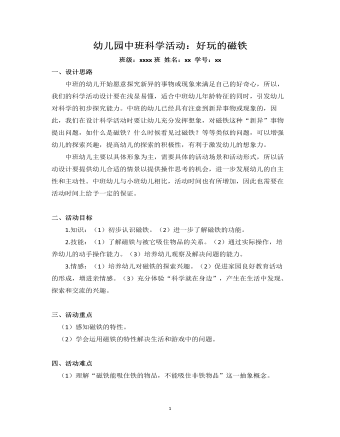
好玩的磁铁教案教学设计
中班的幼儿开始愿意探究新异的事物或现象来满足自己的好奇心,所以,我们的科学活动设计要在浅显易懂,适合中班幼儿年龄特征的同时,引发幼儿对科学的初步探究能力。中班的幼儿已经具有注意到新异事物或现象的,因此,我们在设计科学活动时要让幼儿充分发挥想象,对磁铁这种“新异”事物提出问题,如什么是磁铁?什么时候看见过磁铁?等等类似的问题,可以增强幼儿的探索兴趣,提高幼儿的探索的积极性,有利于激发幼儿的想象力。 中班幼儿主要以具体形象为主,需要具体的活动场景和活动形式,所以活动设计要提供幼儿合适的情景以提供操作思考的机会,进一步发展幼儿的自主性和主动性。中班幼儿与小班幼儿相比,活动时间也有所增加,因此也需要在活动时间上给予一定的保证。